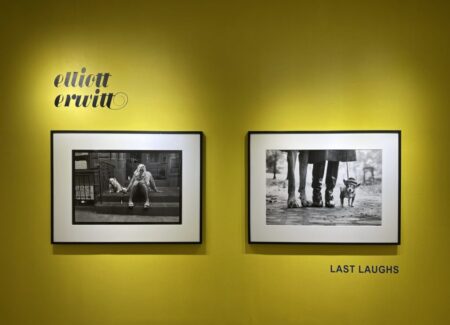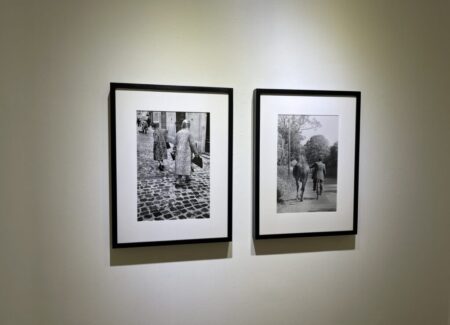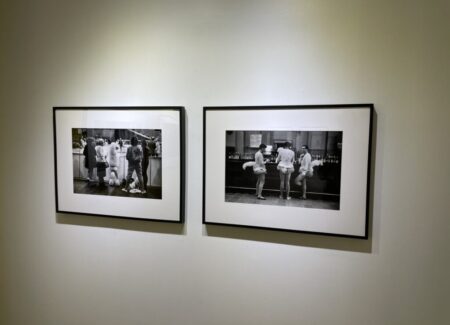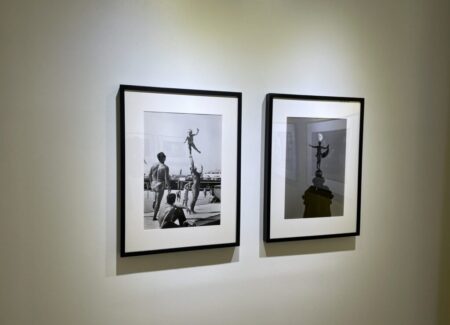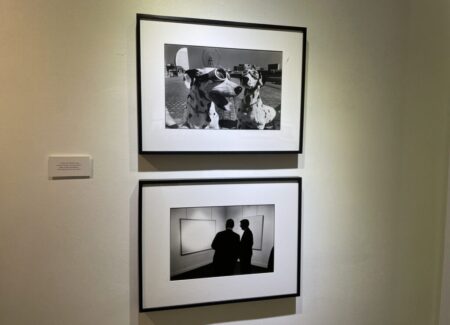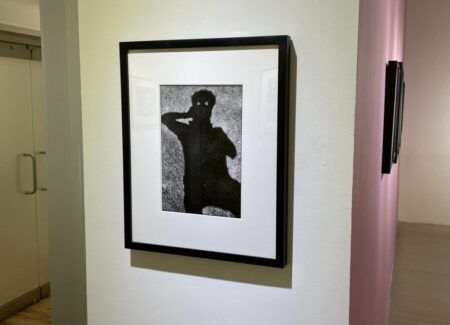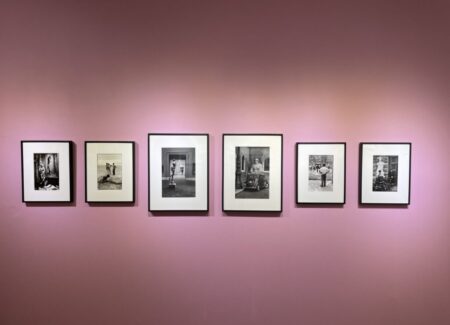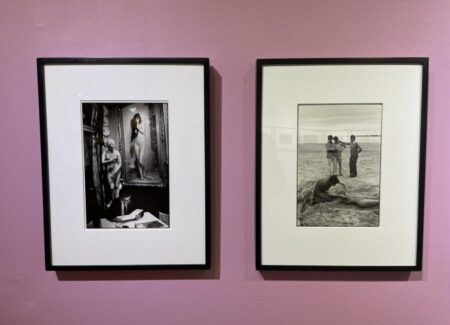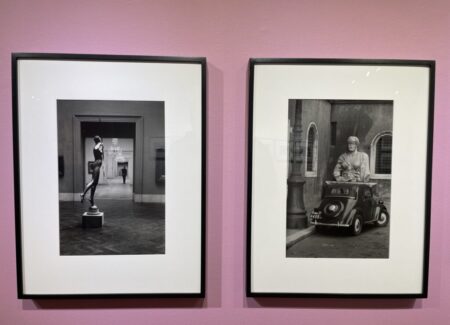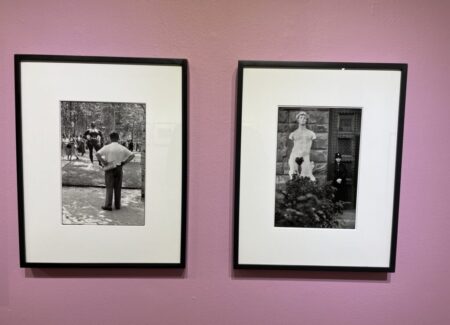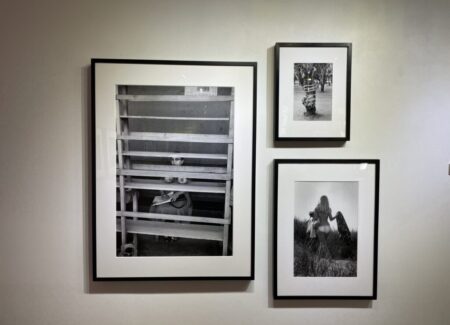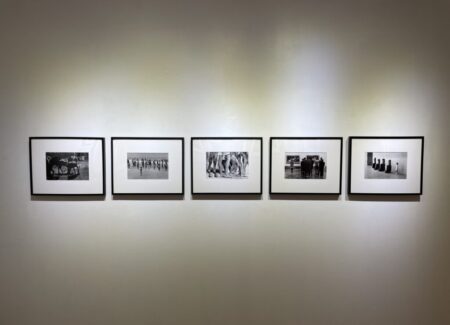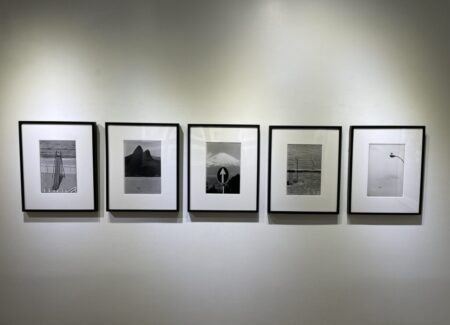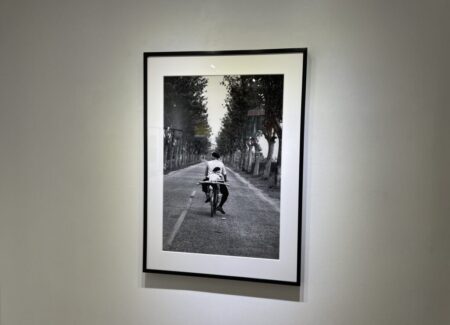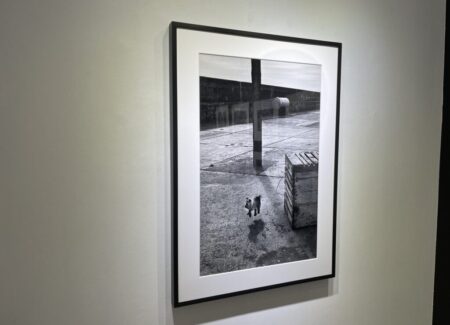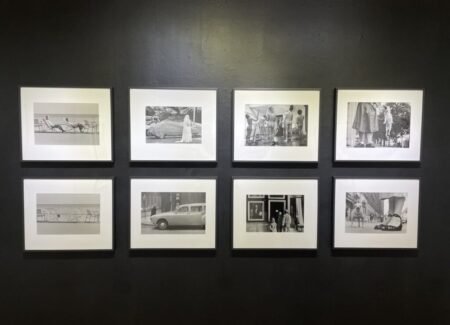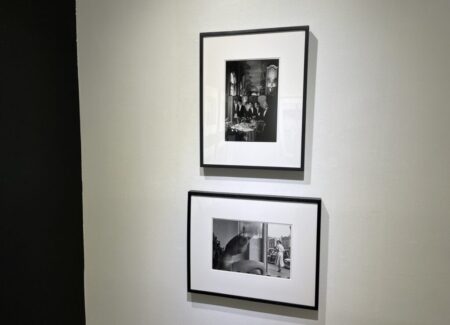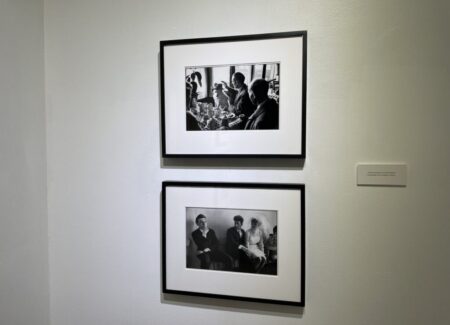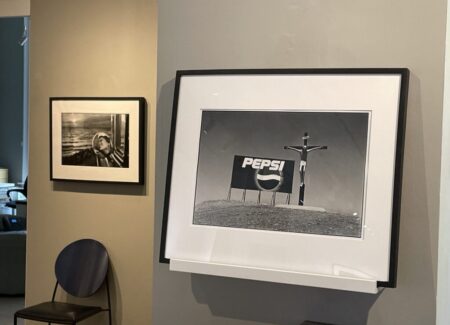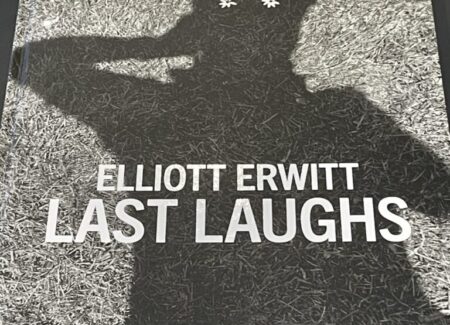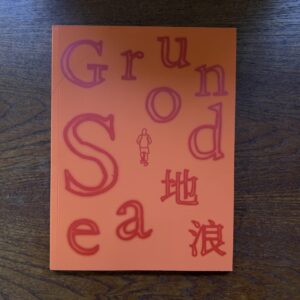JTF (just the facts): A total of 46 black-and-white photographs, framed in black and matted, and hung against yellow, pink, black, and white walls in the main gallery space and the office area. (Installation shots below.)
The following works are included in the show:
- 20 gelatin silver prints, 1950/lifetime, 1957/lifetime, 1959/lifetime, 1961/lifetime, 1962/lifetime, 1963/lifetime, 1965/lifetime, 1967/lifetime, 1968/lifetime, 1969/lifetime, 1972/lifetime, 1973/lifetime, 1975/lifetime, 1977/lifetime, 1988/lifetime, 1990/lifetime, 1991/lifetime, 1993/lifetime, 1995/lifetime, 11×14 inches
- 13 gelatin silver prints, c1950/lifetime, 1953/lifetime, 1955/lifetime, 1957/lifetime, 1962/lifetime, 1963/lifetime, 1975/lifetime, 1979/lifetime, 1983/lifetime, 1989/lifetime, 2001/lifetime, 2003/lifetime, 16×20 inches
- 1 set of 2 gelatin silver prints, 1975/lifetime, each 16×20 inches
- 6 gelatin silver prints, 1955/lifetime, 1956/lifetime, 1968/lifetime, 1991/lifetime, 1995/lifetime, 20×24 inches
- 5 gelatin silver prints, 1955/lifetime, 1957/lifetime, 1968/lifetime, 1974/lifetime, 2000/lifetime, 30×40 inches
A monograph of the same title has been published in 2025 by teNeues (here). Hardcover, 10 5/6 x 13 3/8 inches, 208 pages, with approximately 120 tritone reproductions. (Cover shot below.)
Comments/Context: Summer is a common time for low stakes thematic gallery shows, and Staley-Wise has tapped into the relaxed vibe of the season with a selection of black-and-white photographs by Elliott Erwitt, tied together by his consistent eye for visual humor. Capturing photographic absurdity is much harder than it looks, and across his long career in documentary photography (the works in this show span six decades), Erwitt found much more than his fair share, undeniably placing him on the shortlist of master observers of photographic comedy. Again and again, Erwitt crafts moments of wry visual cleverness, making this survey show extremely easy to like.
Erwitt passed away in 2023, and while there hasn’t been a comprehensive reappraisal of his career since then, in his later life, he had a relatively recent double shot of museum exposure here in New York at the ICP, with a full retrospective in 2011 (titled “Personal Best”) followed by another selection of 1950s works in 2018 (reviewed here). And while Ewritt produced memorable of-the-moment photojournalism across his career (in his role as long time member of Magnum Photos), it is his lighter scenes of irony and humor that will likely be his most lasting artistic legacy.
“Last Laughs” (and the photobook monograph of the same name) is a globe-trotting affair, skimming across decades and continents with equal aplomb. We might reasonably assume that photographic humor is often a right-place-right-time moment where the photographer just happens to be present when something funny happens. And of course there are a few examples of this kind of split-second luck here (a man riding by on a bicycle with a horse, a pair of flippers sticking up from the water in Rio, a woman in a bridal gown passing by a similarly covered car) but for the most part, Erwitt’s humor is more of the hiding-in-plain-sight variety, where he notices something odd in the currents of everyday life swirling around him, in many cases, where the humor wouldn’t even occur to us without Erwitt’s eye to point it out.
It’s certainly possible to group Erwitt’s images by subject matter, and perhaps draw the conclusion that he found dogs, museums, beaches, the behavior of crowds, or the light bawdiness of female bodies (both real and suggested) particularly funny, and maybe he did. Quite often, Erwitt seems to have keyed in on the process of looking, where he is watching others who are watching something else take place, creating a nesting effect of layered observation and reaction that consistently produced visual jokes and ironies. He did this at Versailles with a crowd looking at a label instead of the nearby paintings, in the Prado where a woman looks at Goya’s “Clothed Maja” while a group of men crowds around the “Nude Maja” nearby, and in the 7th Street Gallery in New York where silhouetted men look at blank all white paintings. Once the idea of looking enters your head, you’ll see it consistently in Erwitt’s choices: in a group of men watching a man sculpt a sand castle of a woman, in waiters (and a chef) looking out the window of the Ritz in Paris, of a bridal couple looking at another man sitting nearby, and a woman looking back at a mannequin in a storefront window seemingly watching her.
Erwitt is similarly attentive to momentary echoes of pose, which he isolates for comedic effect. A man stands with his hands on his hips, just like a statue in Gorky Park in Moscow, the two seeming to look at each other. A guard stands with her hands in clasped in front of her in Florence, just like a nearby statue covered by a fig leaf. A young girl joins a line of Egyptian statues at the Met, standing still like another stony figure. And two older ladies in animal print coats pass each other on the cobblestones in Saint Tropez. Erwitt then turns the tables and investigates clever inversions, like nude students in a painting class with a clothed model, or deck chairs in Cannes alternately filled and empty.
Erwitt’s visual affinity for dogs has been well documented in many exhibitions and books over the years, and this show reprises many of his most beloved images. Stylistically, a funny dog picture can of course be simple and straightforward, like a dog in a hat or a dog wearing sunglasses, both of which appear here. More durably interesting are Erwitt’s experiments with scale and vantage point, where he gets down low, to ground (or dog’s eye level), and then plays with the relative sizes of nearby feet. One of his classic images features a tiny chihuahua matched with the tall leather boots of its owner and the tall feet of a much larger dog (perhaps a Great Dane), all three sets of legs lined up for the picture; other images repeat this idea with dogs standing and jumping on city sidewalks around the world. Still other images find a dog in a car window (as though driving), a poodle standing on its back legs watching a dog show, and dogs sitting on a stoop aligned just so to replace the owner’s head with that of one of the dogs, each a quiet exercise in seeing the world differently.
Another group of images are smart compositional studies, where Erwitt uses his own spatial creativity to align the frame in a way that creates humorous juxtapositions. He places the moon on the head of a statue atop the Schloss Charlottenburg in Berlin and an arrow pointing up at the top of Mount Fuji in Japan, and has even more fun with fruits placed in the slats of a window like breasts, the Diana statue at the Met shooting her arrow at a man walking away, and a swimmer seemingly placed atop a playground slide. He also makes more formally-driven pairings, matching a tall spigot with an egret and an airplane with a bird perched on a streetlight. And while many photographers have made cast shadow self-portraits, Erwitt playfully decorates his own with two flowers for eyes.
So when we gather up all these sophisticated photographic strategies into a show, what we actually have is a serious survey of photographic craft successfully masquerading as quirky visual entertainment and light summer fare. Step back and carefully watch what Erwitt is doing in each of these images to better appreciate the art that made the laughs possible.
Collector’s POV: The single prints in this show are priced at $6000, $7500, $10000, $11000, $12000, $13000, and $19000, based on size, with the diptych available at $20000. Erwitt’s photographs are consistently available in the secondary markets, with dozens of prints available every auction season. Recent prices have ranged between roughly $1000 and $26000, with most under $10000.
